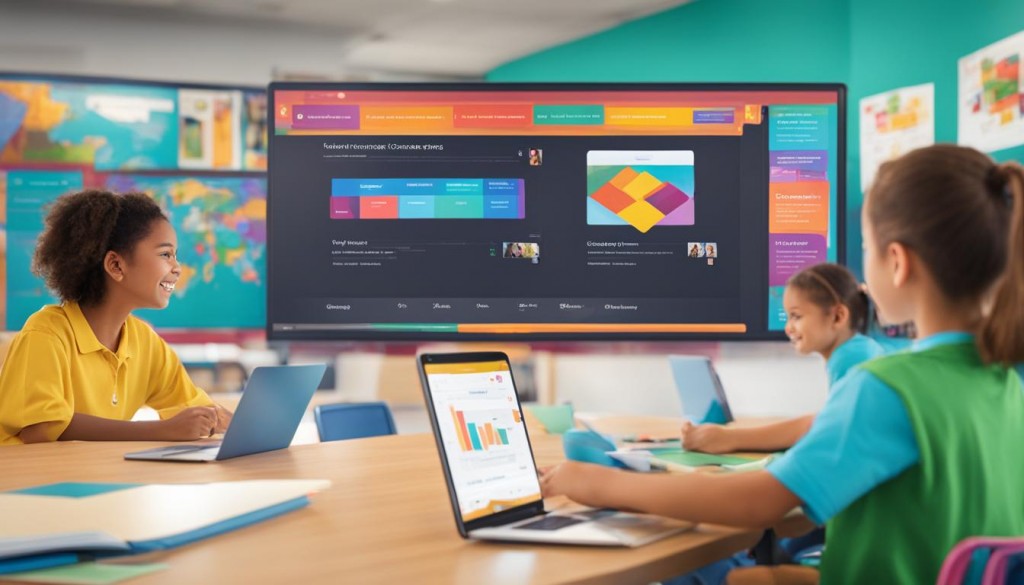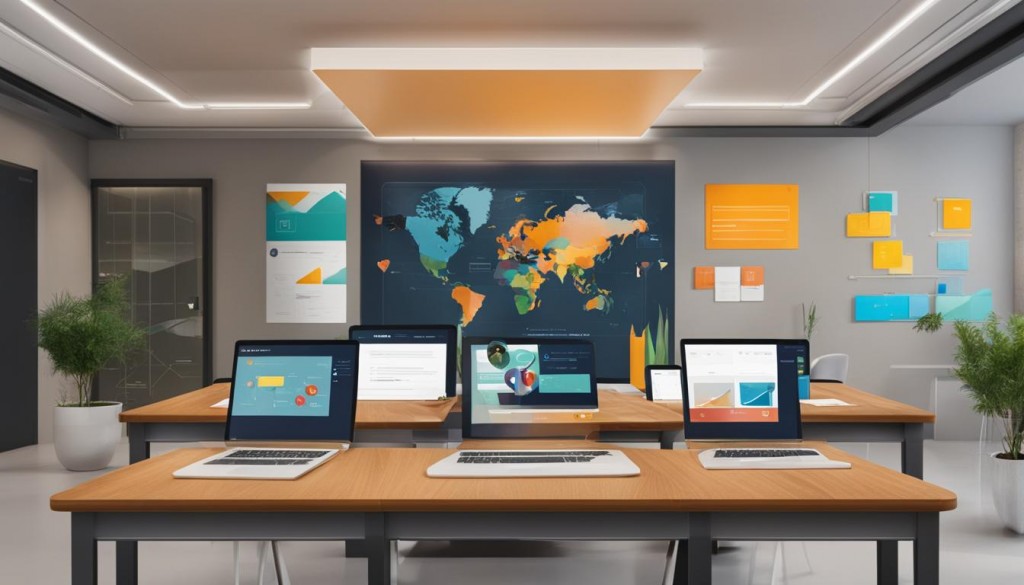July 28, 2025
Welcome to the world of Blended Learning (or combined training) — an area where flexibility and pedagogical effectiveness come together to provide an optimal learning experience. “blended learning definition” comes to light when we talk about this innovative teaching method that combines the convenience of online training with the interaction and richness of face-to-face sessions. By diving into this guide, you will discover what blended learning DEF (complete definition of blended learning) is, and how it is becoming a revolutionary approach in the world of education and continuing vocational training.The concept of blended learning encompasses more than a simple juxtaposition of traditional and modern teaching methods. It is a true pedagogical strategy designed to meet the specific needs of today's learners, who seek autonomy and adaptability in their learning journey. Combined training, as a central pillar of blended learning, is therefore the subject of particular attention in our analysis. Get ready to grasp all the subtleties of this popular learning modality.
The Blended Learning, also known under the term of blended learning, represents an innovative teaching method that merges the benefits of online learning with those of traditional face-to-face approaches. Thanks to theblended learning, learners benefit from an enriched and diversified training path, which combines the flexibility of digital media with direct interaction between trainers and students. blended learning strategy effective is characterized by its ability to adapt to the different learning styles of individuals, offering everyone the opportunity to progress at their own pace and according to their preferences. The personalization of the learning journey, a cornerstone of hybrid training, thus increasing the motivation and commitment of participants.
In summary, hybrid training is emerging as a relevant response to the current needs for continuing education and training, effectively combining autonomy and support, face-to-face training and digital learning.
The Blended Learning - blended learning, is not a concept born in the last decade. Its origin dates back to the emergence ofelearning And of the distance education, when educational technologies began to take root in the field of training. It was only later with the advent of the Internet and the generalization of online training that blended learning has grown in popularity. The end of the 90s marked a significant turning point with the introduction of online education platforms, while the beginning of the 21st century was the scene of a real revolution with the democratization of access to high-speed Internet. This has allowed greater flexibility in the design of training, thus promoting a more enriched and diversified pedagogical approach. The historical progression of Blended Learning is a direct result of these technological developments.
Blended learning is a harmonious blend of tradition and innovation, bringing together the best of both worlds to create an unprecedented learning experience.
This blend of traditional and modern methods has paved the way for personalized learning, where each individual can learn at their own pace and according to their preferences. Contemporary didactic strategies embrace this educational philosophy by introducing new interactive and collaborative tools. With the constant increase in learning technologies, we can expect that the future of Blended Learning is further enriched by advances such as the integration of augmented and virtual realities into the learning process.
The concept of Blended Learning, or hybrid learning, is becoming more and more widespread in the educational and professional spheres. This teaching method, which combines the advantages offered by a mix of face-to-face courses and online training via blended learning platforms, offers a series of significant benefits.
Students benefit considerably from Blended Learning thanks to the flexibility and autonomy offered by this learning method. In addition to a better balance between their personal life and their studies, learners enjoy easy access to educational resources at any time.
For trainers and businesses, the Blended Learning represents a significant advance in the management of education and vocational training. It allows a better analysis of the needs and progress of each learner and offers a gateway to innovative teaching methods.
By observing the pros and cons ofthe Blended Learning, it is interesting to focus on the central role played by blended learning platforms. These provide an essential infrastructure for the effective implementation of the hybrid training.aspectBenefits for learnersBenefits for trainers and organizationsAccessibilityTraining available 24/7 Large-scale deployment without geographic constraintInteractivityModules elearning engaging and interactiveCreation of dynamic learning pathsPersonalizationAdaptation of the pace and learning journeyPrograms that can be adjusted in real time according to performanceProfitabilityReduced costs compared to fully face-to-face trainingSignificant savings on logistical and material costsThis information highlights the strategic importance of Blended Learning, especially with continuous developments in the digital field that tend to reinforce these benefits.
La combined training has undeniable advantages but also raises various issues. One of the central concerns lies in the integration and effective use of digital learning tools, which require technical mastery on the part of both learners and trainers. Unequal access to technology is another critical issue, which is likely to widen the digital divide and exclude some participants from the benefits of hybrid learning.In addition, the motivation of learners by distance education can vary considerably due to the lack of a structured and supervised learning environment, which requires increased personal discipline. Finally, the creation of a harmonized and efficient pedagogical framework for combined training is a real challenge. It requires careful design to ensure that the online and face-to-face components complement and mutually enrich the educational experience.ChallengeImplicationBypass StrategyMastery of digital toolsNeed for familiarization and training in technologyPractical tool training, technical supportPractical tool training, technical supportFair technology accessEquitable technology accessDisparities in access to hardware and the InternetHardware loan programs, grants for Internet accessLearners' motivationRisk Remote dropout sessions interactive and collaborative, individualized monitoringInstructional designNeed for coherence between online and face-to-face modulesIntegrated course planning, continuous feedback for adjustments
The rewarding experience of the hybrid training depends greatly on the ability to meet these challenges and build a balanced and inclusive learning system.
The adoption of a blended learning strategy is proving to be a decisive step towards a hybrid training efficient. This requires a thorough understanding of learners' needs and learning goals in order to provide a flipped pedagogy And a modern learning. Let's look at the essential steps to get there.
Careful analysis is the first step to success. Identifying the gaps that need to be filled and developing clear and measurable goals provides a solid foundation for training that precisely meets the needs of learners.
A well-designed educational path is one that integrates the principles of hybrid training, exploiting the flexibility of digital technology while maintaining the advantages of direct interaction. It should be flexible and able to adapt to diverse learning styles.
The selection of digital tools is crucial. They should be intuitive, engaging and promote active pedagogy, allowing learners to build their knowledge independently and collaboratively.ToolsFeaturesBenefitsUse in reverse pedagogyLMS platformContent management, progress monitoringCentralization of resources, monitoring of progressCentralization of resources, personalization of the learning pathwayDistribution of prior course materialDistribution of pre-course materialInteractive quiz toolsRapid quiz creation, immediate returnsFormative assessment, learner engagement Preliminary knowledge evaluationApplications of CollaborationShared workspaces, instant messageRemote group work, easy communicationGroup projects, online discussions
The Blended Learning, known for its ability to effectively combine online and face-to-face learning modes, finds a perfect complement in the flipped pedagogy. The latter, by overturning the traditional order of exposure of theory and then practice, encourages students to become actors in their learning prior to classroom sessions. The integration of these two methodologies in a learning platform promotes a modern learning and tailor-made. The synergy between these two approaches takes the form of optimization of face-to-face time, used to deepen knowledge, and online time, dedicated to the introduction of concepts. In this context, the learning platform becomes the central space where the learner accesses educational resources, performs exercises, and assesses comprehension, thus preparing the ground for more interactive and productive face-to-face sessions.

At the forefront of educational innovation, the learning platform must be intuitive, versatile and rich in resources. We have presented below the essential characteristics of a platform adapted to this synergy:FeaturesBenefits for autonomous learningBenefits for face-to-face sessionsInteractive multimedia contentIncreased learner involvementSupport to facilitate debates and practical workshopsCollaborative featuresCollaborative featuresTeamwork and knowledge sharing even remotely Facilitating group work and collective projectsDiscussion spacesExchanges with peers and trainers, clarification of Doubts Preparation of questions and discussions for face-to-face sessionsFormative AssessmentsImmediate feedback on progressionIdentification of points to be studied in classPersonalized monitoringAdaptation of the course according to everyone's needs and rhythmBetter understanding of individual needs by the trainer
The combination of blended learning and flipped pedagogy brings about the emergence of a pedagogical paradigm where the autonomy and empowerment of the learner are at the heart of the educational experience.
The implementation of this duality requires a thorough reflection on the tools and structure of the learning platform chosen, which should accompany and reflect the philosophy of this modern approach. The future of education and vocational training is being written with greater interactivity and a focus on the learner, where each individual can trace their path towards even more robust knowledge.
In a constantly evolving educational context, the blended learning platform is proving to be the backbone of an effective and contemporary teaching strategy. These platforms rely on digital learning tools advanced to create an environment where the interaction and personalization of teaching are optimized. Let's take a closer look at the strength of these systems.
The effectiveness of a platform dedicated to blended learning lies in its ability to integrate various essential components. Intuitiveness of the interface, mobile compatibility, integration of multimedia resources, and personalized monitoring of the learner, are all characteristics that define a robust solution that is appreciated by both trainers and students.
Choosing the right platform may seem daunting, but a meticulous comparison of the features offered can greatly facilitate the decision. Let's take a look at some popular options on the market and how they measure up against one another.PlatformAccessibilityCollaborative ToolsAnalytical SupportDiversity of ResourcesMoodleHighForums, WikisDetailed ReportsBroad Range of PluginsBlackboardHighEmbedded Messaging, HighEmbedded Messaging, GroupsPerformance DashboardsRich Educational ResourcesHigh CanvasGroup Work, VideoconferenceAnalyticsPredictionAnalyticsActivesEasy multimedia integrationThis overview helps us to understand the match between user needs and specificities of each platform. This is the key to fully exploiting the potential of digital learning tools and promote an enriching and tailor-made learning experience.
The effectiveness of a hybrid training is largely based on the careful choice of online training content. The integration of different types of educational resources in an environment ofelearning requires strategic selection to best meet varied learning needs.
The variety of formats and interactivity are key in creating content for a blended learning that stimulates engagement and makes it easier to remember.
For a clear overview of the assortment of content to adopt, here is a list of the types of resources that can enrich your communication system. hybrid training :
To illustrate how these various elements can be harmonized, consider the following table, which associates each type of content with its recommended learning objectives and instructions:Content typeEducational objectivesIntegration into e-learning interactive instructional videosInteractive instructional videosVisual and auditory engagement, interactivityVisual and auditory engagement, interactivityDidactic and auditory engagement, interactivityDidactic modules, self-trainingSerious simulations and gamificationPractical activities, gamificationCase studiesCritical analysis, problem solvingIndividual or group work, discussion forumsAudio podcastLearning flexibility, accessibilityMobile add-in, lesson reviewInfographicsData visualization, memorizationReference resources, course materialOnline testsKnowledge assessment, immediate feedbackFormative Assessments, Competency AssessmentFormative Assessments, Competency AssessmentsCollaborative WorkspacesCollaborative WorkspacesInteractivity, TeamworkGroup Projects, BrainstormingA relevant combination of these contents will not only improve the learning experience, but also to guarantee the acquisition and the effective assimilation of knowledge and skills within the framework of combined training. Always remember to align content with your learners' goals and learning styles for maximum impact.
In a world where themodern learning requires increased flexibility, a balance between face-to-face sessions and those ofelearning becomes a central point of a combined training effective. How do we ensure that this balance contributes optimally to the individual's learning journey?
Personal interactions play a crucial role in building knowledge and building critical social skills. These interventions should be targeted and designed to maximize learner engagement and the practical application of skills acquired online. A group work session, an interactive case study, or a practical workshop can be valuable elements of this face-to-face component.

The shutter elearning blended learning is based on a learning platform solid and intuitive. The aim is to offer varied and quality online resources, ranging from videos to interactive quizzes, thus facilitating self-directed and personalized learning. This digital support must be accessible and engaging to support the learner in his journey towards autonomy and mastery of the targeted skills. In the end, it is a question of intelligently juxtaposing these two worlds to create an enriched and complete learning experience, true to the spirit ofmodern learning and to the effectiveness of the combined training.
The success of a blended learning strategy is based on the ability to constantly monitor progress and assess the effectiveness of training. Monitoring and evaluation are not only final steps, but integrated components throughout the learning process, ensuring that educational goals are aligned with the evolving needs of learners.
Formative assessment methods are put in place to provide continuous feedback to learners and trainers. They allow for real-time adjustment of teaching techniques and content. At the same time, the summative evaluation generally takes place at the end of the training, validating the skills and knowledge acquired. This is a crucial aspect of follow-up of the training, which contributes to awarding certifications and measuring the return on educational investment.
THElearning assessment produces a significant amount of data that, if properly analyzed, becomes a powerful tool for the continuous improvement of training programs. Data collection not only makes it possible to personalize learning according to individual needs, but also to identify trends and globally adapt the blended learning strategy for greater efficiency and relevance.
Blended learning or blended training is a type of training that combines face-to-face and distance learning. It is more flexible and allows for more effective results than traditional training.
The benefits are numerous. Blended learning saves a significant amount of time by reducing face-to-face training time. It offers flexibility in terms of training and makes it possible to adapt the blended learning course according to the individual needs of each person. In addition, blended learning courses often allow access to more diverse training modules via digital learning or mobile learning.
The disadvantages of blended learning may include the need for good time management and self-discipline on the part of learners. In addition, not all learners have the same access to technology, which can be a barrier for some.
Effective blended learning training must take into account the specific needs of the learner and offer a balanced combination of face-to-face and distance learning. Best practices may include the use of virtual classrooms, social training, and adapted modules.
Blended learning is for anyone who wants to have a flexible training that combines the best aspects of face-to-face and distance learning. This can vary from students to professionals who want to train continuously.
Blended training is especially beneficial when learners are geographically dispersed, when complex topics require both classroom sessions and personal work, or when flexibility is a priority.
Digital learning is a key element of blended learning. It allows access to online training resources, makes training more interactive and engaging, and reinforces traditional classroom or face-to-face training.
The cost of blended learning training can vary, but it is often more economical than fully face-to-face training, especially when you take into account time savings and reduced travel costs.
A blended learning training module is a teaching unit that is part of a hybrid training course. It can consist of online teaching materials, virtual classroom sessions, social activities, or other components of a blended learning program.
Adapting best practices to blended learning involves remaining flexible and responsive to learners' needs, integrating effective teaching techniques, using technological tools strategically, and aligning the goals of the training path with those of the individual or the organization.Training through blended learning platforms, offers a series of significant benefits.
Students benefit considerably from Blended Learning thanks to the flexibility and autonomy offered by this learning method. In addition to a better balance between their personal life and their studies, learners enjoy easy access to educational resources at any time.
For trainers and businesses, the Blended Learning represents a significant advance in the management of education and vocational training. It allows a better analysis of the needs and progress of each learner and offers a gateway to innovative teaching methods.
By observing the pros and cons ofthe Blended Learning, it is interesting to focus on the central role played by blended learning platforms. These provide an essential infrastructure for the effective implementation of the hybrid training.aspectBenefits for learnersBenefits for trainers and organizationsAccessibilityTraining available 24/7 Large-scale deployment without geographic constraintInteractivityModules elearning engaging and interactiveCreation of dynamic learning pathsPersonalizationAdaptation of the pace and learning journeyPrograms that can be adjusted in real time according to performanceProfitabilityReduced costs compared to fully face-to-face trainingSignificant savings on logistical and material costsThis information highlights the strategic importance of Blended Learning, especially with continuous developments in the digital field that tend to reinforce these benefits.
Des formations conçues par des experts métier, régulièrement mises à jour pour coller aux exigences terrain. Découvrez nos modules les plus suivis et les mieux notés par les professionnels.

Formation complète sur les Bonnes Pratiques de Fabrication (BPF) adaptée à votre profil professionnel dans l'industrie pharmaceutique et vétérinaire.

Maîtriser les techniques et les procédures essentielles.

Les procédures essentielles d'hygiène et de sécurité pour le personnel...